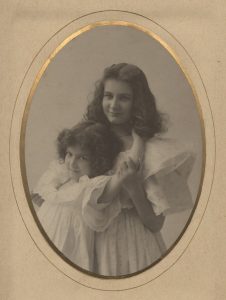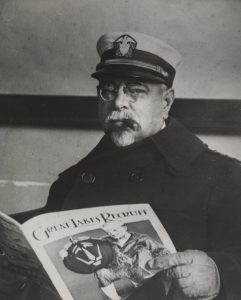By Sammi Merritt
Following the 2024 discovery of time capsules in the cornerstones of the Main Library and McKinley Health Center, we have wondered whether there might be more “copper boxes” hidden throughout campus. Upon further investigation, it appears that these cornerstone boxes may be more common than we imagined.
Early 20th century newspaper articles indicate that it was a common practice – not only on campus, but around the world – to include such a “copper box” in new building cornerstones. In those days, as now, it was common to hold a cornerstone laying ceremony to lay the cornerstone for new buildings. Over 265 (digitized) articles from Illinois newspapers, including 30 articles from the Daily Illini, suggest that a core purpose of this ceremony was to fill and encapsulate these boxes within the cornerstone. On May 9, 1924, in anticipation of the cornerstone laying ceremony for McKinley Hospital (now McKinley Health Center), the Daily Illini states this clearly: “The big box that dominates every cornerstone laying is being filled with the numerous articles today…”
Programs and photos from these ceremonies, which were held for many new campus buildings, can be found in the Archives in record series 2/0/808 Building and Statue Dedication Programs and 39/2/20 Photographic Subject File, respectively. Many photographs from these ceremonies actually depict the copper box being enclosed within the cornerstone, such as the two from the McKinley Hospital ceremonies linked below.
Campus news sources covered the deposit of some boxes, but not all of them. Although the Champaign News Gazette published a list of the contents of the capsule in the Main Library’s cornerstone, The Daily Illini published nothing on the box. Conversely, The Daily Illini published many details about the copper boxes in McKinley Hospital and the Architecture Building’s cornerstones.
A full list of university buildings which are known (as of June 2025) to contain a copper box can be found below. It is possible that more will be discovered as additional sources are identified, and that more undocumented cornerstone boxes will come to light as buildings reach the end of their life on campus.
(Note that university buildings on the Chicago campus and local Champaign-Urbana buildings have been omitted from this list, but many of these buildings do contain copper boxes confirmed in the source below; notably the Champaign and Urbana City Buildings.)
[A copy of this blog post can be found in the Archives’ ready reference file on “Buildings, University.”]
University of Illinois Buildings Which Contain Time Capsules
All buildings with known or suspected time capsules are listed below, in chronological order of their cornerstone laying.
Four main sources were used to confirm the presence of time capsules/copper boxes in the following list:
- The Daily Illini Newspaper (record series 41/8/801)
- Board of Trustees Reports (record series 1/1/802)
- Photographic Subject File (record series 39/2/20)
- Champaign News Gazette (accessed via microfilm in the History, Philosophy, and Newspaper Library)
The sources which confirm the presence of each box are included beneath the building name, with the digitized source linked where possible.
Legend
(Current building name [if different from original name])
[x] Building no longer exists
* Time capsule has already been retrieved
^ Indicates a time capsule that has been or will be replaced
[?] Suspected time capsule (not confirmed)
1871
- University Hall [x]*
[x] Building demolished in 1938.
*Time capsule retrieved in 1938 and placed into the Gregory Hall cornerstone in 1939.- The Daily Illini, May 15, 1938, pp 1
- The Daily Illini, May 21, 1938, pp 1
- The Daily Illini, December 16, 1945, pp 3
- The Daily Illini, October 6, 1962, pp 4
1892
- Natural History Building
- The Illini, March 12, 1892, pp 16
- Board of Trustees Minutes, 1892, pp 223
1896
- Library Hall (Altgeld Hall)
- The Illini, September 18, 1896, pp 562
1906
- Auditorium (Foellinger Auditorium)
- The Illini, May 31, 1906, pp 1
1907
- University YMCA (later Illini Hall) (1907) [x]*
[x] Building demolished in February 2023.
*Time capsule retrieved February 14, 2023 and opened on September 30, 2023 during 150th Anniversary celebration.- Maggie Knutte. “What Was Found in the Illini Hall Time Capsule.” College of Liberal Arts & Sciences Blog, February 8, 2024
- “University YMCA to create new time capsule for 2073.” The Daily Illini, March 6, 2024
1909
- Osborne Hall (Chi Omega Sorority House)
- The Daily Illini, May 11, 1909, pp 5
1910
- Lincoln Hall^
^To commemorate the renovation of Lincoln Hall, a new time capsule was installed on August 16, 2013, with the intention of being opened in 2063 on the 150th anniversary of the building’s dedication.- Board of Trustees Minutes, September 20, 1910, pp 22
- “Lincoln Hall takes time capsule suggestions.” The Daily Illini, March 14, 2012
- [Old] “Time Capsule” [contents], The Lincoln Hall Project, http://www.lincolnhall.illinois.edu/timecapsule/cornerstone/
- [New] “Time Capsule” [contents], The Lincoln Hall Projects,
http://www.lincolnhall.illinois.edu/timecapsule/
1912
- Commerce Building (Old)
[Note that The Daily Illini refers to this as the “New” Commerce Building, but this is 12 years before construction of the “New” New Commerce Building, which was dedicated on the same day as the “New” Library and “New” Gymnasium in 1924.]- The Daily Illini, May 21, 1912, pp 1
- The Daily Illini, May 22, 1912, pp 1
- 1912 Senior Memorial: “Eternal Flame”
- The Daily Illini, May 28, 1912, pp 1
1913
- 1913 Senior Memorial: “Quad Gateway” (Lincoln Hall Gate)*^
*Retrieved in January 2015.
^Replaced with additional items on January 28, 2015.- The Daily Illini, September 27, 1913, pp 4
- Jason Chun. “Time capsule found in Lincoln Hall Gateway.” The Daily Illini, February 12, 2015
- Julie Herman. “100-year-old time capsule found in Lincoln Hall gateway.” University of Illinois News Bureau, March 5, 2015
1914
- Chemistry Building (Noyes Laboratory)
- RS 39/2/20 Photographic Subject File, BUI – Noyes Laboratory Construction 1902-15, ID #0003952
1915
- Ceramics Building
- The Daily Illini, September 28, 1915, pp 1
1916
- Women’s Residence Hall (Busey Hall)
- The Daily Illini, October 21, 1916, pp 4
1917
- Tina Weedon Smith Memorial Building (Smith Hall) [?]
[?] Suspected to have a time capsule containing phonographic discs of the University Band due to mention of recordings made for this purpose in 1909 DI- The Daily Illini, May 6, 1909, pp 1
1920
- Wesley Foundation Building
- The Daily Illini, April 22, 1920, pp 8
1922
- Agricultural Extension Building
- The Daily Illini, November 9, 1922, pp 2
1924
- McKinley Hospital (McKinley Health Center) *^
*Retrieved on March 24, 2025 as part of 100th Anniversary celebrations.
^To be replaced in 2025.- The Daily Illini, June 3, 1924, pp 7
- See also: McKinley Hospital Addition (1961)
- New Library (Main Library) *^
*Retrieved in October 2024 as part of 100th Anniversary celebrations.
^To be replaced in 2025.- Champaign News Gazette, June 8, 1924, pp 1
- The Daily Illini, June 6, 1924, pp 1
- New Commerce Building (David Kinley Hall)
- Champaign News Gazette, June 8, 1924, pp 1
- The Daily Illini, June 6, 1924, pp 1
- New Men’s Gymnasium (Huff Hall)
- Champaign News Gazette, June 8, 1924, pp 1
- The Daily Illini, June 6, 1924, pp 1
1926
- Building for Architecture and Kindred Subjects (Architecture Building)
- The Daily Illini, November 12, 1926, pp 1
- RS 2/0/808 Building and Statue Dedication Programs
1928
- Materials Testing Laboratory (Arthur Newell Talbot Laboratory/Bioacoustics Laboratory)
- RS 2/0/808 Building and Statue Dedication Programs – Laying of the Corner Stone of the Materials Testing Laboratory, October 25, 1928.
1930
- Women’s Gymnasium
- The Daily Illini, November 25, 1930, pp 1
1931
- Sigma Nu House
- The Daily Illini, April 21, 1931, pp 5
1934
- University Place Church
- The Daily Illini, September 16, 1934, pp 9
1937
- YMCA Building
- The Daily Illini, November 12, 1937, pp 1
1939
- Gregory Hall
- The Daily Illini, June 9, 1939, pp 1
- The Daily Illini, June 11, 1939, pp 1
- Illini Union
- The Daily Illini, February 8, 1941, pp 9
- The Daily Illini, October 24, 1942, pp 3
- The Daily Illini, February 28, 1943, pp 8
1948
- Mechanical Engineering Building
- The Daily Illini, March 16, 1948, pp 3
1951
- McKinley Memorial Church
- The Daily Illini, June 5, 1951, pp 5
- Animal Science Lab
- The Daily Illini, October 2, 1951, pp 2
- RS 8/1/2 Agriculture Dean’s Office Subject File, Box 7, Folder “Laboratory, Cornerstone Box, 1950-51”
- Lutheran Chapel
- The Daily Illini, December 11, 1951, pp 5
1955
- Bevier Hall
- RS 39/2/20 Photographic Subject File, Box BUI – Bevier Hall, Folder “Bevier Hall 1954-56,” ID #0003119
- RS 8/1/2 Agriculture Dean’s Office Subject File, Box 7, Folder “Cornerstone Box, 1955, 1960”
1958
- Biology Building
- The Daily Illini, March 29, 1958, pp 4
- The Daily Illini, April 1, 1958, pp 1
1961
- McKinley Hospital Addition
- RS 39/2/20 Photographic Subject File, Box 71, Folder “BUI Health Center,” ID #0011159
1962
- Student Services Building
- The Daily Illini, September 14, 1962, pp 3
- RS 41/1/20 Fred H. Turner Papers, 1918-1975, Box 35, Folder “St: (Student Services Cornerstone, 1962)”
1963
- College of Education Building
- The Daily Illini, April 18, 1963, pp 10
1978
- Morrow Plots
- RS 8/1/57 Agriculture, Consumer, and Environmental Sciences Photograph File, 1868-2015, Box 24, Item: “2004-017, State FFA members bury a time capsule at the west center of the Morrow Plots, mislabeled as 2004-013 on backs of photos, Morrow Plots, College Admin – Admin, 2004.”
- Architecture Building – Temple Buell Gallery
- The Daily Illini, April 27, 1978, pp 9
1981
- Alma Mater Statue *^
*Time capsule placed in the 1980s was retrieved in 2012.
^ Replaced in 2014.- Claire Hettinger. “Alma Mater Time Capsule to Showcase Campus Life.” The Daily Illini, April 1, 2014
- Dani Demmerle. “How to Encapsulate Time: An Educational Guide to Optimize the Preservation of Time Capsules.” Bunsen and Bronte: C-U at the Lab Blog, April 15, 2024
1987
- Beckman Institute
- The Daily Illini, February 9, 1987, pp 5


